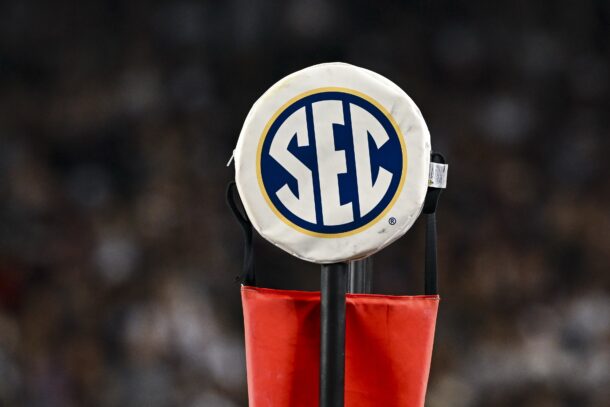
Next Tuesday the college football selection committee will begin meeting every week to determine which four teams to select for the 2015 College Football Playoffs. With the first official rankings set to come out Nov. 3 (7:30 p.m. Eastern, ESPN), it’s time to begin our analysis of who’s in and who’s out.
The 12-member selection committee’s final pairings will be released Sunday, Dec. 6 at noon ET, with the five most likely points of emphasis for the next five weeks listed below:
- Conference championships won
- Strength of schedule
- Head-to-head competition
- Comparing results against common opponents
- Relative factors that may have altered a team’s performance (injuries)
Conference Championship potential
Picking four conference champions from the Power-5 conferences (SEC, Pac-12, Big 10, Big 12, and the ACC) is easily the best way to make their final decision , especially this season as the Pac-12 is the only one without an undefeated team. Right now this would be the most obvious selection method, but if/when the undefeated teams start losing, it will become a question of which conference is stronger.
Who’s in: Ohio State or Michigan State, TCU or Baylor, LSU, and Clemson.
Who’s out: Pac-12 teams, Notre Dame, mid-majors.
Takeaways: Assuming a Big Ten and Big 12 champions go undefeated, a one-loss SEC champion would be virtually impossible for the committee to kick out, but if Alabama, LSU, Utah, Notre Dame, and Clemson all finish with one loss, which two get picked?
Strength of Schedule
Without four undefeated teams, the conference championship strategy will fail to pick out four clear champions, at which point the committee will have to factor in a timeless tool of the BCS era, the strength of schedule. If the committee took the four best teams every year, then they would be hard-pressed not to include at least two SEC teams at this point in the season.
Who it helps: SEC teams, Utah.
Who it hurts: Big Ten teams, Florida State, TCU, Baylor, mid-majors.
Takeaway: No. 1 Ohio State has yet to play a Top 25 ranked team, whereas Alabama has played four in eight games. A loss in the SEC this season simply has more value than one in the Big 10, Big 12, Pac-12, or ACC.
Head-to-Head Outcomes
Only a few games feature Top 25 vs. Top 25 matchups, but college football’s had its fair share of heavyweight matchups already this fall. Non-conference showdowns featuring nationally-ranked competition often provide fans a glimpse of separation between contenders and pretenders. Winning those “spotlight” games gives any team a significant edge in terms of comparative strength at the end of the season.
Who it helps: Clemson, Oklahoma, Utah, Michigan State, LSU, Alabama
Who it hurts: Michigan, TCU, Baylor, Ohio State, Notre Dame
Takeaways: No play has had a bigger impact on the selection committee than the blocked punt return for a TD to end the Michigan and Michigan State game. The victory puts Michigan State on equal footing with Ohio State for Big 10 contention and effectively eliminates the Wolverines chances of winning the conference.
Common Opponent Results
Determining team strength and strength of schedule of all 25 ranked teams can make your head spin, but it’s much easier to interpret when breaking it down logically. Utah (6-1) had been the Pac-12’s highest ranked team since Week 6, but after losing 42-24 to a USC team that Stanford (6-1) beat 41-31 in Week 3 they dropped behind the Cardinal. Despite sharing the same record, No. 8 Stanford sits well ahead of No. 13 Utah after beating a common opponent.
Who it helps: Stanford, Clemson.
Who it hurts: Utah, Florida State.
Takeaways: In a Big 12 with four teams ranked in the Top 14, each of which play one another in the final month, this factor will weigh heavily with the committee.
- Oklahoma State plays TCU, followed by Baylor, followed by Oklahoma.
- TCU plays Oklahoma State, followed by Oklahoma, followed by Baylor.
- Baylor plays Oklahoma followed by Oklahoma State, followed by TCU.
- Oklahoma closes with Baylor, TCU and Oklahoma State.
All of that happens in a four-week span.
Relevant Factors including injuries
The least predictable factor used to determine CFP participants is injuries. Selection committee members could theoretically throw out a one-loss team’s only blemish if a key player did not play. On that same note, an injury to a star player can effectively eliminate a team’s chances of making the playoff.
Who it helps: Ohio State.
Who it hurts: Baylor, Georgia.
Takeaways: The two most significant injuries this season have been to Georgia RB Nick Chubb and Baylor QB Seth Russell. Already with two losses it’s hard to see Georgia’s loss of Chubb impacting the selection committee next week, but No. 2 Baylor just lost its starting quarterback for the season. Ohio State survived a similar situation last season, but with three consecutive games against Top 15 opponents to end November it’s hard to see Baylor coming out of the Big 12 anymore.
Final Verdict
With a very clear idea of who the top four conference champions are at the moment, unless there’s a major upset this weekend, the committee will use the “Conference Championship Potential” to determine who the top four teams are for the first playoff selection committee of 2015. Look for these four to lead the way:
- Ohio State (8-0)
- TCU (7-0)
- LSU (7-0)
- Clemson (7-0)
Note: TCU gets the nod over Baylor because of ‘Relevant Factors including Injuries’
Parting thought: Just one of the top 4 teams in the first rankings last season made the playoff and Ohio State opened last year at No. 16. We’ve got a long way to go and a lot of football still to be played.







